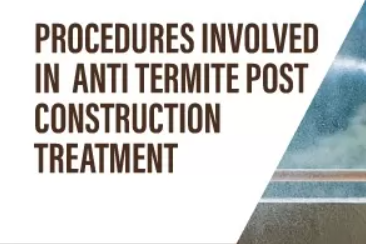Termites are among the most destructive pests, causing significant damage to wooden structures. Understanding the process of anti-termite treatment in construction is essential for homeowners and builders alike. In this comprehensive guide, we’ll explore the steps involved in effective termite prevention and treatment, ensuring your property remains safe from these unwanted invaders.
1. Understanding Termites
- Types of Termites: Briefly describe the different types (subterranean, drywood, and dampwood termites).
- Signs of Infestation: Explain how to identify a termite problem early on, including droppings, mud tubes, and damaged wood.
2. Importance of Anti-Termite Treatment
- Preventing Damage: Discuss the potential costs associated with termite damage.
- Value Addition: Explain how effective termite treatment can enhance property value.
3. Steps Involved in Anti-Termite Treatment
3.1 Pre-Construction Anti-Termite Treatment
- Soil Treatment: Discuss the application of termiticides to the soil before laying the foundation.
- Chemical Barriers: Explain how chemical barriers work to deter termites from entering the structure.
3.2 Post-Construction Anti-Termite Treatment
- Drilling and Injecting: Describe the method of drilling into the foundation and injecting termiticides.
- Baiting Systems: Explain how baiting systems can be used to monitor and eliminate termite colonies.
4. Types of Anti-Termite Treatments
- Liquid Treatments: Discuss the use of liquid termiticides, their application methods, and effectiveness.
- Baiting Systems: Explain how baiting systems work and their advantages.
- Physical Barriers: Briefly cover the use of steel mesh and other physical barriers in construction.
5. Choosing the Right Anti-Termite Treatment
- Factors to Consider: Discuss factors like property type, budget, and level of infestation.
- Professional vs. DIY: Explain the benefits of hiring professionals for anti-termite treatment compared to DIY methods.
6. Maintenance and Monitoring
- Regular Inspections: Emphasize the importance of regular inspections post-treatment.
- Ongoing Treatment Plans: Discuss how ongoing treatment can prevent future infestations.
7. Why Choose A to Z Pest Solutions for Anti-Termite Treatment?
- Expertise and Experience: Highlight the qualifications and experience of the A to Z Pest Solutions team.
- Customized Solutions: Describe how the company offers tailored anti-termite treatment plans.
- Customer Satisfaction: Share testimonials or statistics that demonstrate high customer satisfaction.
Effective anti-termite treatment in construction is essential for protecting your property from costly damage. By understanding the process and choosing a reputable service provider like A to Z Pest Solutions, you can ensure your home remains termite-free.













